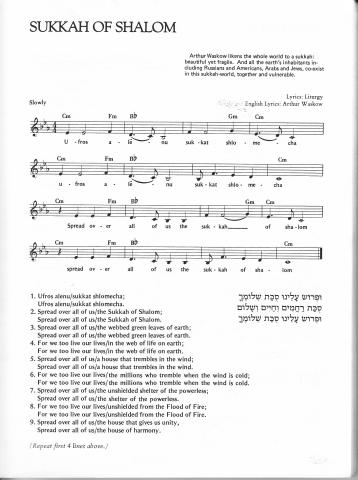Submitted by Rabbi Arthur Waskow on

| Attachment | Size |
|---|---|
| 567.64 KB |
The Jewish harvest festival of Sukkot in 2010 begins the evening of September 22 and lasts for seven days, to be followed at once by a separate festival of closure and inwardness. There are three crucial teachings embodied in Sukkot:
1) A "sukkah" is a fragile hut roofed with green branches, open to starlight, wind, and rain. Making it watertight makes it not a kosher sukkah. Its vulnerability is crucial.
The evening prayers say, as we prepare for sleep and seek some security through the vulnerable night, "Spread over all of us Your sukkah of shalom." Why not a fortress of shalom, or a castle, or a temple, or a tower? Why not something sturdier, hard-shelled, invulnerable –won't that get us more peace, more security, as we sleep?
The wisdom of the prayer is that in fact all human beings do live in a vulnerable "sukkah," and we can achieve true peace and security if we all recognize that and share our vulnerability with each other --neither in fear and hiding, nor by threat and attack.
2) The festival is focused on the health of the earth, the interplay of all life which brings the harvest that feeds us all. In the ancient Temple, there was a ceremony of offering water on the first day – pouring it into a sacred spout right next to the Altar. Rabbi Akiba taught that our pouring water was intended to remind God to pour water – that is, to send the rain so crucial to the arid Middle East."
So Sukkot is a powerful moment to affirm healing and protection of the earth. Take one of the seven days to write your local newspaper about the need to preserve the power of the EPA to limit CO2 emissions -- despite efforts by Big Coal and Big Oil to cripple the EPA
3) The Torah prescribes the offering of 70 bulls at the Temple during Sukkot. The ancient rabbis said this was to implore God for prosperity and joy not for the people of Israel alone but for all the 70 nations of the world. So Sukkot is a powerful time to focus on peace making and to welcome as guests into the sukkah people from all religious and national origins.
We can do that figuratively by reading from the various sacred teachings of the different cultures of the world, or literally by inviting people of different backgrounds to come visit with us. Even if we have not built a physical sukkah, we can sit together in a quiet outside space, sing together, eat together, share our hopes and prayers.
For additional teachings about the meanings of Sukkot, click here for a treasury of essays.
In celebration of all these teachings, we offer the song at the start of this essay. If you click on the graphic, it will expand to full size. You can also access it to print out for yourself by clicking below.



















